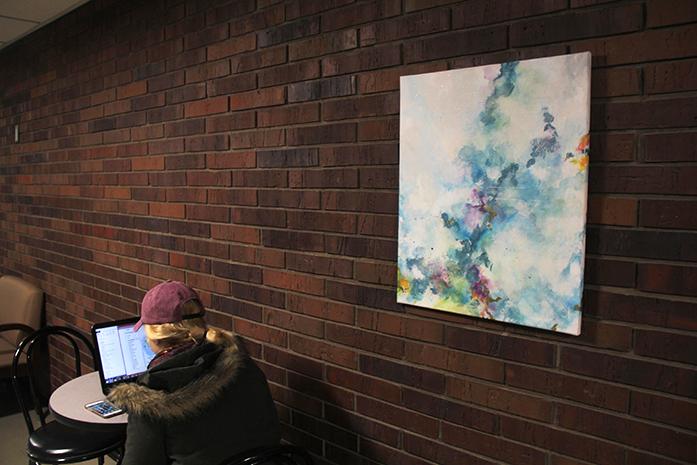By Tessa Solomon
Take a trip to the Writing Center and meet Maya Angelou. Resting outside the center’s entrance, her gaze welcomes each stressed student and patient teacher. Rendered in oil, she calls canvas home, as one of nine new paintings brightening the University of Iowa’s English-Philosophy Building.
For years, students have hurried through EPB’s halls, deciphering poetry or pondering Plato. The building is a hub of creativity, housing the premiere writing university’s Iowa Review and acclaimed nonfiction MFA program.
Despite the colorful content taught in its classrooms, the building was austere. Bare brick walls accentuate the dim halls’ monochrome palette. Ceiling tiles are frayed, gray, or missing.
“The EPB does not reflect all the creativity it could foster with a more visual environment,” said UI student Bethany Kilburg, painter of “For Kelly.”
Small changes have been made over the years, often spearheaded by one determined individual. This year, sophomore Shelby Woods initiated a makeover. A member of the Art Ambassador Program, she began forming a project early.
“The ambassadors’ goal is to find ways to improve campus, specifically in the arts,” Woods said. “My project was to hang paintings in the English-Philosophy Building in the hopes to join hands with the writing community, to even inspire writers.”
Woods, a studio art major with a focus in photography, broached the possibility of submissions with other art students, aware of their frustrations.
“A lot of art students don’t have a lot of opportunities to showcase their paintings,” she said. “I thought this could be that opportunity.”
She worked with Barb Pooley, EPB Administrative Services Administrator, to obtain permission from university officials. Both discovered soon, though, that approval was the least of their problems.
“Even if we got permission, how do we hang paintings on a brick wall? There were codes, fire hazards, so many things to overcome before we could even get to that place,” Woods said.
Its heavy brick interior is a part of its history. Constructed in the late ‘50s and early ‘60s, the EPB’s rigorous design of beige concrete and unrelenting rectangular symmetry invokes a fortress. Woods was not the first to notice — and combat — that Spartan nature. Pooley led her own interior revolution.
“One of the things I noticed right away when I started working here was that students were all sitting on the floor [in the hallway] with their legs out,” Pooley said.
With university funding, Pooley furnished the halls with the now-familiar eclectic chairs and tables, a task that continues today. But why has it taken the individual effort of Pooley and Woods to contest the atmosphere? Is there something about the EPB that stagnates change?
“I think everyone that has come to the U of Iowa since 1968 has had one class in this building, so despite the atmosphere, it has some nostalgic appeal,” Pooley said.
Unfettered by nostalgia and armed with professional drill, Woods spent over four hours hanging submissions on the first floor. Often using Pooley’s furniture to reach higher, she drilled into the brick mortar.
Nine students, including her, submitted to the project, each sharing her sentiments.
“All art is inspired by art of different mediums, too,” said junior Veniesa Dillion. “Most painters listen to music, and people who listen to music paint or read poems. It all comes full circle.”
The paintings can be appreciated until the spring semester. Then the EPB will see fresh canvas on the walls, as submissions open again to all studio arts students. The process will have to be adopted by another ambassador once Woods graduates, but for now the project is far from over.
“There’s a staleness in many buildings where there should be inspiration,” Woods said.



